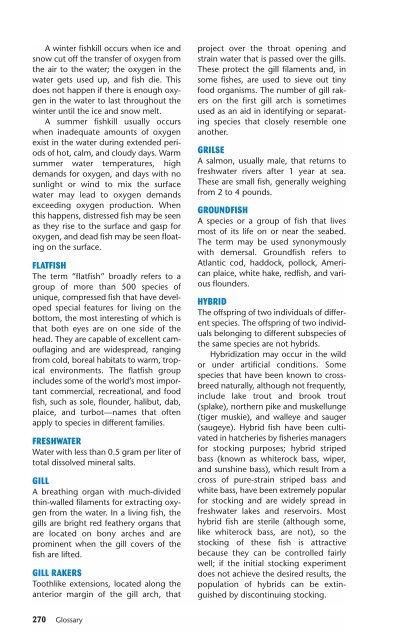Ken Schultz's Field Guide to Saltwater Fish - Macaw Pets store
Ken Schultz's Field Guide to Saltwater Fish - Macaw Pets store
Ken Schultz's Field Guide to Saltwater Fish - Macaw Pets store
You also want an ePaper? Increase the reach of your titles
YUMPU automatically turns print PDFs into web optimized ePapers that Google loves.
A winter fishkill occurs when ice and<br />
snow cut off the transfer of oxygen from<br />
the air <strong>to</strong> the water; the oxygen in the<br />
water gets used up, and fish die. This<br />
does not happen if there is enough oxygen<br />
in the water <strong>to</strong> last throughout the<br />
winter until the ice and snow melt.<br />
A summer fishkill usually occurs<br />
when inadequate amounts of oxygen<br />
exist in the water during extended periods<br />
of hot, calm, and cloudy days. Warm<br />
summer water temperatures, high<br />
demands for oxygen, and days with no<br />
sunlight or wind <strong>to</strong> mix the surface<br />
water may lead <strong>to</strong> oxygen demands<br />
exceeding oxygen production. When<br />
this happens, distressed fish may be seen<br />
as they rise <strong>to</strong> the surface and gasp for<br />
oxygen, and dead fish may be seen floating<br />
on the surface.<br />
FLATFISH<br />
The term “flatfish” broadly refers <strong>to</strong> a<br />
group of more than 500 species of<br />
unique, compressed fish that have developed<br />
special features for living on the<br />
bot<strong>to</strong>m, the most interesting of which is<br />
that both eyes are on one side of the<br />
head. They are capable of excellent camouflaging<br />
and are widespread, ranging<br />
from cold, boreal habitats <strong>to</strong> warm, tropical<br />
environments. The flatfish group<br />
includes some of the world’s most important<br />
commercial, recreational, and food<br />
fish, such as sole, flounder, halibut, dab,<br />
plaice, and turbot—names that often<br />
apply <strong>to</strong> species in different families.<br />
FRESHWATER<br />
Water with less than 0.5 gram per liter of<br />
<strong>to</strong>tal dissolved mineral salts.<br />
GILL<br />
A breathing organ with much-divided<br />
thin-walled filaments for extracting oxygen<br />
from the water. In a living fish, the<br />
gills are bright red feathery organs that<br />
are located on bony arches and are<br />
prominent when the gill covers of the<br />
fish are lifted.<br />
GILL RAKERS<br />
Toothlike extensions, located along the<br />
anterior margin of the gill arch, that<br />
270 Glossary<br />
project over the throat opening and<br />
strain water that is passed over the gills.<br />
These protect the gill filaments and, in<br />
some fishes, are used <strong>to</strong> sieve out tiny<br />
food organisms. The number of gill rakers<br />
on the first gill arch is sometimes<br />
used as an aid in identifying or separating<br />
species that closely resemble one<br />
another.<br />
GRILSE<br />
A salmon, usually male, that returns <strong>to</strong><br />
freshwater rivers after 1 year at sea.<br />
These are small fish, generally weighing<br />
from 2 <strong>to</strong> 4 pounds.<br />
GROUNDFISH<br />
A species or a group of fish that lives<br />
most of its life on or near the seabed.<br />
The term may be used synonymously<br />
with demersal. Groundfish refers <strong>to</strong><br />
Atlantic cod, haddock, pollock, American<br />
plaice, white hake, redfish, and various<br />
flounders.<br />
HYBRID<br />
The offspring of two individuals of different<br />
species. The offspring of two individuals<br />
belonging <strong>to</strong> different subspecies of<br />
the same species are not hybrids.<br />
Hybridization may occur in the wild<br />
or under artificial conditions. Some<br />
species that have been known <strong>to</strong> crossbreed<br />
naturally, although not frequently,<br />
include lake trout and brook trout<br />
(splake), northern pike and muskellunge<br />
(tiger muskie), and walleye and sauger<br />
(saugeye). Hybrid fish have been cultivated<br />
in hatcheries by fisheries managers<br />
for s<strong>to</strong>cking purposes; hybrid striped<br />
bass (known as whiterock bass, wiper,<br />
and sunshine bass), which result from a<br />
cross of pure-strain striped bass and<br />
white bass, have been extremely popular<br />
for s<strong>to</strong>cking and are widely spread in<br />
freshwater lakes and reservoirs. Most<br />
hybrid fish are sterile (although some,<br />
like whiterock bass, are not), so the<br />
s<strong>to</strong>cking of these fish is attractive<br />
because they can be controlled fairly<br />
well; if the initial s<strong>to</strong>cking experiment<br />
does not achieve the desired results, the<br />
population of hybrids can be extinguished<br />
by discontinuing s<strong>to</strong>cking.


